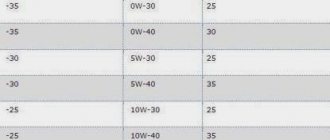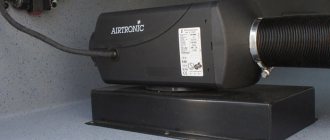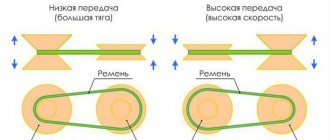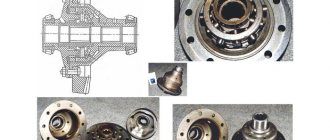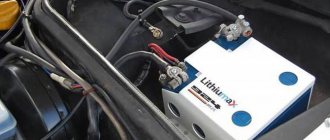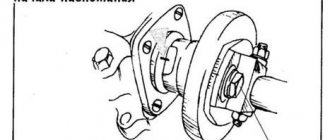How much will HBO cost?
The cost of gas equipment for a car depends on the kit. It includes:
- electronic control unit;
- gearbox;
- balloon;
- filling device;
- multivalve;
- filter;
- nozzles;
- highways;
- switch button.
For each engine, a kit is selected either from one manufacturer or prefabricated. For example: the ECU is from Stag, and the gearbox, cylinder and injector are from Lovato.
The price of HBO is affected not only by its layout, but also by the type of cylinder. It can be cylindrical - installed in the trunk, or toroidal - for installation in a niche instead of a spare wheel. The latter is more expensive.
The more powerful and complex the engine, the more expensive the gas equipment will cost. The price of equipment is from 11 thousand rubles.
What determines the price of installing 6th generation gas equipment?
The high price of gas equipment for a 6th generation car is a key factor that limits the spread of such systems. To convert new cars with direct injection to gas, foreign-made kits are used (most often from the Dutch brand Vialle). The total cost depends on:
- The type of power plant of the car (GBO-6 for an 8-cylinder engine is more expensive than for 6 or 4-cylinder units).
- Difficulties in installing equipment.
The first parameter affects the type of equipment to be installed. But the price for installing gas equipment of the 6th generation will be different in different workshops. To minimize costs, but get a guarantee of quality, you should entrust installation work to our specialists.
How to choose the right equipment for your car?
A car owner who has not previously encountered gas equipment will find it difficult to decide on its choice. To avoid problems with the engine in the future, you should entrust the selection, installation and configuration of LPG to trusted specialists. Based on the characteristics of the internal combustion engine, they will select the necessary equipment and advise on operation issues.
It is worth considering that the gasoline engine is not designed to work with gas. Therefore, car manufacturers, when installing factory gas equipment, also make changes to the internal combustion engine, adapting it to work on gas.
Which HBO is better to choose?
Communities VAZ Repair and Modification Blog Cleaning the throttle valve of the VAZ 2115. Faulty lambda probe oxygen sensor
Any 1st or 2nd generation gas system is suitable for a car carburetor. Yes, at the moment there are already 3rd and 4th generations, but for this type of engine it will be useless. Since they differ from older models in the presence of electronics, and there are no corresponding sensors on a carburetor engine, and therefore it is not worth installing the latest models. They will automatically turn into 1-2 generations.
There are practically no differences between the first generation and the second generation HBO. The gas hose is connected to the carburetor through a spacer-mixer or through an insert into the carburetor. Under the influence of vacuum in the intake manifold, gas from the gearbox enters the carburetor through the dispenser. The only difference is the gas dispenser.
In the first generation, the gas dispenser is manual; it is set to the desired position once and requires virtually no adjustment. And the second generation has an electronic dispenser, with a valve that interacts with the engine depending on the readings of the oxygen sensor and the position of the carburetor throttle valve.
This second-generation system is not entirely suitable for classic cars. But you can easily make 1st generation HBO from it. To do this, simply replace the electronic dispenser with a mechanical one. For a carburetor, the first generation LPG will be the best option.
Pros and cons of installing HBO
Taking into account driver reviews, we can formulate the advantages and disadvantages of gas equipment on cars.
Positive sides:
- Significant savings on refueling. No matter how fuel prices rise, gas always remains cheaper than both gasoline and diesel. The price of HBO pays off a year after its installation.
- Low load on the engine. Gas has a higher octane number, which means it burns longer, reducing the load on the internal combustion engine. The gas + air mixture is more uniform, does not dry out the cylinders, and does not affect the consistency of the oil, which increases the service life of the engine.
- Minimal damage to the environment. The exhaust gas contains two-thirds less harmful substances than the exhaust from gasoline or diesel.
- Increased mileage from refueling to refueling. The car runs on two types of fuel, so when gas runs out, you can drive on gasoline.
- Safety. Rumors that an LPG cylinder could explode due to temperature changes or shock were denied by the German car owners' protection club ADAC. Under his supervision, crash tests of cylinders were carried out under fire and accident conditions. The results were satisfactory.
A few downsides:
- Not every gas station has a gas filling station. LPG repairs are carried out only at specialized service stations.
- Slight reduction in speed, drop in engine power by 15%.
- The influence of high and low temperatures. If the car heats up under the rays of the sun, the gas pressure in the cylinder increases. To reduce it, you need to produce several liters. In cold weather, gas liquefies and refuses to enter the system. So in winter you can start the engine only on gasoline.
- Increase in car weight. The entire design of the gas equipment adds 60 kg to the weight of the machine. A cylinder installed in the trunk takes up an average of 40 liters of space.
- Gas leak. The likelihood of this is small, but present in case of improper operation and untimely maintenance.
Installation of HBO 4th generation
At a specialized station, the car owner will be offered a wide range: from the selection of LPG to installation and full configuration. They will give a guarantee and advise. The price of the issue varies from 30,000 to 70,000 rubles.
Experienced specialists know where it is best to place the reducer, how to connect the antifreeze line and carefully route the gas supply and filling pipes.
You can install and configure 4th generation HBO yourself.
Where to carry out the work?
Gas equipment is installed on a trestle or in a box with a pit. It is necessary to have a set of tools, protective gloves and good lighting.
Selecting a location for mounting the gearbox
Necessary installation conditions:
- The gearbox installation location must be easily accessible for removing it and replacing filters;
- the gearbox must be mounted on the machine frame, and not on the engine, in order to avoid vibrations;
- the supplied hoses and tubes should not be twisted or broken.
After assessing the length of the hoses and accessibility, you can attach the reducer.
Features of connecting hoses for antifreeze:
- they are connected strictly in parallel to the system;
- it is important to determine where the “entrance” and “exit” of antifreeze are located in the stove;
- the hoses are connected (cut in) to the shut-off valve using a tee.
Equipment for storage of cylinders
If a toroidal (for spare tire) cylinder is selected, it is important to place it so that the gas supply and refueling tubes are positioned correctly: they should not come into contact with the hot muffler or vibrating body parts.
The HBO cylinder is rigidly attached, the multivalve is located in its upper part.
Laying the main pipe
The main pipe is necessary for the gas to flow from the cylinder into the reducer. Installation should begin from the gearbox, along the bottom of the car (preferably along the gasoline line) and then connect to the multivalve.
Installation of injectors
First, you need to cut the fittings as close as possible to the gasoline injector, after which the gas injectors are installed. Then the gas supply hoses are connected. They must be the same length, but no more than 18 cm.
Placement of the control unit and sensors
All electronics are installed under the hood. For proper connection, the HBO kit comes with instructions that describe all the wires and contacts.
After the installation is complete, start the car. The first three times we turn the key in the ignition switch without starting the engine. This is necessary so that the fuel pump creates the necessary pressure in the rail. After this, the car can be started. If everything is done correctly, then the next step will be setting up the 4th generation LPG with your own hands.
Self-removal of gas equipment
Sometimes it becomes necessary to dismantle gas equipment from a car. This may be caused by engine repair, preventative maintenance of the gas system itself, or simply a desire to return to the car’s standard fuel supply system. Of course, this only applies to non-standard installation of equipment, that is, in the case of installation of gas equipment in specialized centers. This description applies to 4th generation HBO, the price of which is acceptable for everyone. It is worth noting that work related to the installation and dismantling of gas equipment is considered high-risk work. The same as any work on the car’s fuel system.
Such work should only be carried out in an open, well-ventilated area, always on an elevated surface, taking maximum precautions. There should be no open fire nearby; there should be a carbon dioxide fire extinguisher within easy reach
Disconnecting the cylinder, draining the remaining gas. If possible, maximum fuel is produced from the cylinder. On a multivalve, both taps are closed - filling and supply. The consumable hose is disconnected, and a flexible rubber hose, more than a meter long, is put on in its place. The free end of the hose is lowered into an open-top container, such as a metal bucket. The supply valve opens and the remaining gas begins to flow out of the cylinder into the container. The gas comes out in liquid and gaseous states, the process is accompanied by strong cooling, so work is carried out with gloves. The condensate that has accumulated in the container is poured onto the ground provided there is good ventilation. Then the tap is closed and the cylinder can be removed. After dismantling, the cylinder is left with the taps open, the multi-valve facing down, for the final release of pressure. An empty cylinder can only be stored with the multivalve taps closed. Dismantling equipment in the engine compartment Carefully disconnect the main fuel line from the gearbox, dismantle the hoses, injectors, vacuum regulator, and filter. The fittings are unscrewed from the intake manifold, the holes are plugged with bolts using sealant. Using the connection diagrams for the HBO and engine ECU, the injector control signal wires are disconnected. The standard ECU wires, into which the LPG control cables were connected, are connected using a soldering iron. Otherwise the petrol injectors will not be controlled. The same is done with the remaining control wires, according to the connection diagram. After a thorough check of the LPG connection points, we perform a test start of the engine. There should be no noticeable changes in normal operation. In this case, the dismantling of the gas equipment was completed successfully.
Auto articles
More news on the topic
Repairing the car's fuel system Removing the driveshaft Possible malfunctions in the lubrication system of the car's internal combustion engine If there is a burning smell in the car
What to configure?
To adjust the parameters of newly installed gas equipment, you will need a laptop, a program for setting up gas equipment of the 4th generation and a special cable.
There are many programs such as Zenit JZ, KME NEVO or STAG. They are similar in appearance (interface), each can be downloaded from the official website and installed. Let's consider the program for setting up the 4th generation STAG gas equipment.
Its interface is quite functional. The instructions for setting up the 4th generation HBO are simple and clear. The meaning of each parameter is deciphered in additional footnotes that pop up when you hover the cursor.
The values set at the LPG manufacturer's factory are immediately displayed. If the gas equipment is not new, then the information from the controller will be displayed in the program. It will indicate how often the gas was used, how many times diagnostics and adjustments were carried out.
If there is new controller firmware, the program will immediately prompt you to install it.
You can buy a cable for setting up the 4th generation HBO, or you can make it yourself based on the PL2303 board.
A little history
Communities VAZ Repair and Improvement Blog The spark was lost on the VAZ 2107
Unlike the 4th generation LPG, the connection diagram of previous generations did not require any special skills, and each gas motorist often coped with the installation independently. Then the gas installation was a primitive set of elements - a cylinder with a multi-valve, a reducer-evaporator and an insert into the manifold - this is GBO1-2. Plus to the list - shut-off valves.
In early versions of gas equipment, the driver personally comprehends the intricacies of the gas business. But the 4th generation HBO connection diagram does not provide such an opportunity, although many still try.
The evolution of gas equipment has led to a natural result - the process is controlled by electronics (ECU). On the one hand, this added complexity to the system, and the cost of HBO became higher. But on the other hand, the interaction of the elements of the gas installation with the components and assemblies of the car has improved: injection has become more accurate, the operation of the internal combustion engine on gas is more economical.
Settings options
The main window of the program contains the main indicators by which the ECU operates:
- conditions under which switching from gasoline to gas or vice versa will occur (temperature, engine speed, pressure);
- gas fraction (gas pressure after the reducer);
- vacuum in the manifold;
- injection period of gas and gasoline injectors.
The “map” tab displays the operating graph of gasoline (blue curve), gas injectors (green curve) and the conversion factor of gasoline injection to gas (orange line).
On gas equipment that is not adjusted in time, the control unit will completely imitate the operation of gasoline injectors, which will generate an error on the on-board computer. The reason is that the mixture formation of gasoline and gas injectors will be the same, but the octane number of the fuel will be different: what is good for gasoline is incorrect for gas.
Generations of HBO
Fifth generation gas equipment page 1 of 3
If you set a goal for yourself, then finding addresses and a suitable set of gas equipment that fits into your planned cost will not be difficult.
Just think about what kind of gas installation you want to see in your car. They can be divided into five generations, that is, 5 generations. This is what I still want to talk about.
Although there is now an active conversation regarding the 6th generation, which has received several design differences compared to its predecessor.
So I propose to briefly examine each option of gas equipment. This will allow you to understand which installation is best to install in your car. I would not recommend doing this yourself, relying on different videos.
First generation
This is a system equipped with vacuum control and a mechanical dispenser. They were installed only on carburetors. The design is extremely simple, so there were no problems with installation. And the repair is not difficult.
These are cheap, structurally elementary installations that can operate on motors that do not have feedback.
But such gas equipment does not at all comply with norms and standards. Therefore, installing such a system is the worst decision you can make.
Second generation
Here they began to use an electronic dispenser and the principle of operation on feedback. The oxygen sensor played an important role.
But LPG only complies with Euro 1 standards. The design is reliable and durable, significantly superior to the first generation.
Such devices quickly damage spark plugs and also cause constant popping noises while driving. An outdated version, to say the least.
Third generation
In many ways, a complete copy of the second generation, but with electronic dosage for fuel supply. Although there is also a similar system there, it has been significantly improved.
These gas pumps react slowly to attempts to gain speed, and the gas composition is poorly adjusted. Does it make sense to install equipment? No. Why? Yes, because it never reached the required Euro 3 standards.
Fourth generation
The third generation was a complete failure. Therefore, the engineers gained strength and did the fourth. Here you can clearly see how engineering is developing and modern technologies are being applied.
Many believe that in Eastern Europe there is nothing better than the 4th generation of HBO, despite the presence of 5th and 6th generations. Here they note the excellent implementation of control of the injectors, which are responsible for supplying fuel. Complies with Euro 3 standards.
Essentially, this is a copy of the injector, equipped with a nozzle on each cylinder. A risk that paid off.
Fifth generation
The next 5th generation LPG has reached Euro 4 standards. Suitable for cars with any injection engine and compatible with all sensors.
Gas is supplied in liquid form, electromagnetic types of injectors are used in the cylinders, the engine can operate on a cold start and the injector power is not lost, despite the transition from gasoline to gas.
Plus, the system makes it easy to return to gasoline.
Sixth generation
Basically, the 6th generation of HBO resembles its predecessor. But if 5 had a valve block with gas injectors and a pressure regulator, responsible for supplying liquid gas to the manifold, then the new version no longer has all this.
Here the use of a fuel replacement unit or module is provided. It is driven into the fuel line. As a result, it turns out that both gas and gasoline lines are connected to the block. There are no gas injectors here.
From electronics, we note a special control unit connected to the standard ECU of the injection power unit.
Watch the video: how to legalize HBO
Calibration
At idle speed the gas is turned off. The gas ECU measures and remembers the operating parameters of gasoline injectors. Then the operation of one gasoline injector is replaced by the operation of a gas one. All gas injectors gradually turn on.
By alternately increasing and decreasing the injection time of gas injectors, it is necessary to bring the exhaust indicator to the norm (conversion factor). To obtain the gas injection time, this coefficient is multiplied by the gasoline injection time.
After calibration, the machine automatically switches to gasoline. You need to drive it to check the settings.
Adjusting charts
After setting up the 4th generation gas system yourself, it is better not to delete the gasoline card. After checking, the car will run on gas. If the map is deleted, you will have to drive temporarily on gasoline, changing the engine load and speed, until the system creates a new map.
After the test drive, it is recommended to save the settings log. This will allow you to view data on the operation of the equipment and, possibly, find errors.
If the operating schedules of gasoline and gas injectors diverge, then it is necessary to adjust the 4th generation LPG map. To do this, on the orange line we fix the points of divergence and maximum convergence of the green and blue lines - the settings at these points are considered optimal and should not change. Then, on the orange line, we mark the point of maximum divergence between the gas and gasoline lines and lower it to the distance where the lines diverge downward.
We drive the car in different modes and see if the graphs match. If not, then repeat the map settings until the graphs match.
Fuel injection adjustment
Injection adjustment is the second most important phase in setting up the 4th generation LPG with your own hands.
First, we warm up the car to the operating temperature of the gearbox. We switch to gasoline and observe the injection rates of gasoline injectors for five minutes. We turn on the gas again, but continue to monitor the gasoline indicators. If the number has increased, this means a lean mixture; if it has decreased, it means a rich mixture.
You can change this state by adjusting the orange line of the graph: if the mixture is lean, raise the line two clicks; if the mixture is too rich, lower it.
Setting up the gas equipment on the car is complete. If the HBO system works without interruptions: switching between injectors occurs on time and smoothly, the engine does not hesitate, has good dynamics - this means that the settings were made correctly. After some time of operation, you can re-run the diagnostics.
A little theory
As a rule, 4th generation gas treatment systems use two types of gas purification elements:
- Coarse cleaning or liquid phase (located either in the evaporator reducer or in the remote valve in front of it);
- Fine cleaning or gas phase (located on the gas hose after the reducer)
Both are used to purify gas from all kinds of contaminants and impurities that may be contained in the propane-butane mixture.
The function of the coarse filter is to prevent all kinds of debris from entering the reducer-evaporator, while the fine filter element cleans the gas mixture after the reducer and before it enters the nozzles.
It should be noted that the coarse cleaning element is quite similar in structure to gasoline, and the fine phase is a cartridge with rubber seals.
Models
Replacing gas filters with 4th generation gas filters first involves selecting and purchasing those elements that we will replace. If everything is quite simple with the liquid phase filter element, then with the gas phase purification element there are several options.
The simplest fine filter consists of polyester or paper; it costs quite a bit, but it clogs quickly. Most often, such a model does not last more than 6-7 thousand kilometers, and will require premature replacement.
A slightly more expensive model has a sump and is equipped with a polypropylene cartridge. This cleaning element will last 10,000 km. and will prevent gas impurities from entering the injectors. Elements of this type of filtration are the most optimal models for installation.
The most expensive and high-quality element for cleaning the fine phase is the separator. Such an element inside is equipped with some kind of channels, which forces the gas to move in a spiral (like a centrifuge); at the moment of passage, all impurities of the gas mixture fall on the walls of the settling tank and then flow to the bottom.
